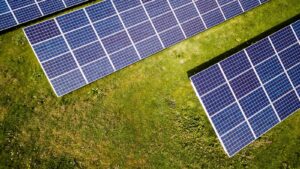How modern football stadiums are getting greener
Michal Karas writes about how the 27 candidates for the latest edition of Stadium of the Year display many ways in which football grounds can become more efficient, smarter and environmentally-friendly, despite often being some of the largest buildings in their respective cities.
Sports stadium often are subject to controversy. If not for the noise and light pollution, then for the funding. If not for safety fears and real estate value, then for traffic. It’s thus worth to take a look how stadium design is changing to mitigate some of the issues, especially the ways in which stadia become more sustainable and may even be a major asset for their neighbours.
During this year’s 9th edition of Stadium of the Year, 27 modern stadia from 11 countries compete for the title of single best one in both the architects’ and the public’s view – through popular vote. Expert stadium architects Robert D Kennedy (Scotland), Alfredo Angulo Quevedo (Paraguay) and Gino Zavanella (Italy) are judging stadiums for their awards, while every internet user can vote for their favourite online for the second award.
Of these candidates, 5 have been cleared to receive either LEED Silver or Gold certificates for sustainability already during design and construction phase. Although all five represent just 2 countries (China and USA), efforts to reduce the ecological footprint span across the world.
Going solar
Perhaps the most popular example is the use of solar power. Vast stadium roofs promote this technology and it’s only expected to grow when photovoltaic cells are efficiently integrated in tensile membrane-type roofs. Among professional stadiums opened in 2018 four have been equipped with solar panels from the start: Generali-Arena in Austria, DVTK Stadion and MOL Arena Sóstó in Hungary and Sun Devil Stadium in Tempe, Arizona.
The last case is a great example that even without a spacious canopy atop the stands, a solar power plant can be delivered. In Tempe two plants were created: one behind the south end, one providing shade throughout the northern parking. Similar effort can be seen in Suzhou, China, where the stadium doesn’t have photovoltaics itself, however, neighbouring commercial building delivers clean energy by these means.
Also, most stadiums can have such systems delivered later into the operation. A vast solar power plant is expected to cover almost all of Audi Field in Washington, D.C.. Almost ironic, since the stadium has one of the smallest footprints of all those opened in 2018 and yet there’s enough space to provide clean power for all daily activities, except for matchday peak, once the system is delivered.
Add to that the ever-improving energy efficiency with BIM systems and waste management. Then the reduction in consumption (introduction of LED in floodlighting and illumination brought up to 60% cut in energy use itself!) and you see what progress is being made in front of our own eyes.
Making use of nature
If you look 20 years back, this was seen as innovative. Now the use of wind, sun and rain allows stadiums to follow at least to some extent the principles of passive building. Rainwater tanks are now almost a must-have feature, dramatically reducing use of public water supply, providing safe source for hundreds of stadium toilets or field irrigation, among other uses. This applies to the smallest candidates, like those from Hungary, to the largest, like the giant Chinese complexes.
Mass introduction of ETFE membranes ensures stadiums are light both within the auditorium and concession areas. Differing in translucency, these materials allow management of how much sunlight accesses the stadium. Just take a look at Volgograd Arena in Russia, covered in 77,000 square meters of various kinds of membranes. Darker blue segments provide sufficient sun protection across its circular promenade, while lighter white sheets ensure there is no needs to use artificial lighting during the day in any open-air area of the stadium.
Natural ventilation is ensured by highly perforated facades, which allow air circulation without necessarily exposing visitors to the elements entirely. A crucial feature for stadiums in tougher climates like continental Russia, where summers tend to be hot and winters – really chilly. When you look at World Cup stadiums, all 7 opened in 2018 meet this principle.
Less steel, fewer cars
These days one in four new stadiums (7 out of 27 in 2018) receives a tensile cable structure. While not necessarily fitting every type of sports venue, this technology is highly effective, while reducing demand for materials exponentially. Depending on case-by-case comparison, such roofs may require up to 80% less steel than regular truss structures. They’re also increasingly intricate and impressive, as exemplified in 2018 by Zaozhuang Stadium, already receiving international and domestic awards for the most complex tensile cable roof to date.
And finally, a feature that will bring joy to fans of energy-friendly transport. More and more stadiums are being built without regular car parking or vastly reduced parking spaces. This might be bad news for fans of American tradition of tailgating, but otherwise it’s a very eco-friendly change, putting focus of such projects on clean transport. Even in Los Angeles, infamous in terms of public transportation, Banc of California Stadium prioritises fans arriving with a bicycle, rail or electric cars.
Let’s go even further: the world’s largest stadium to open in 2018 has virtually no event parking at all! Instead, a beautifully landscaped park was created around Optus Park to welcome people on a daily basis. To provide efficient event transportation for up to 70,000 people on events, large light rail station is put in use, aided by special bus lanes. Even more, pedestrian bridge connects the venue with Perth city centre. If one wants to come by car, it’s still possible. But two largest public parking sites are both places 1 kilometer away.















